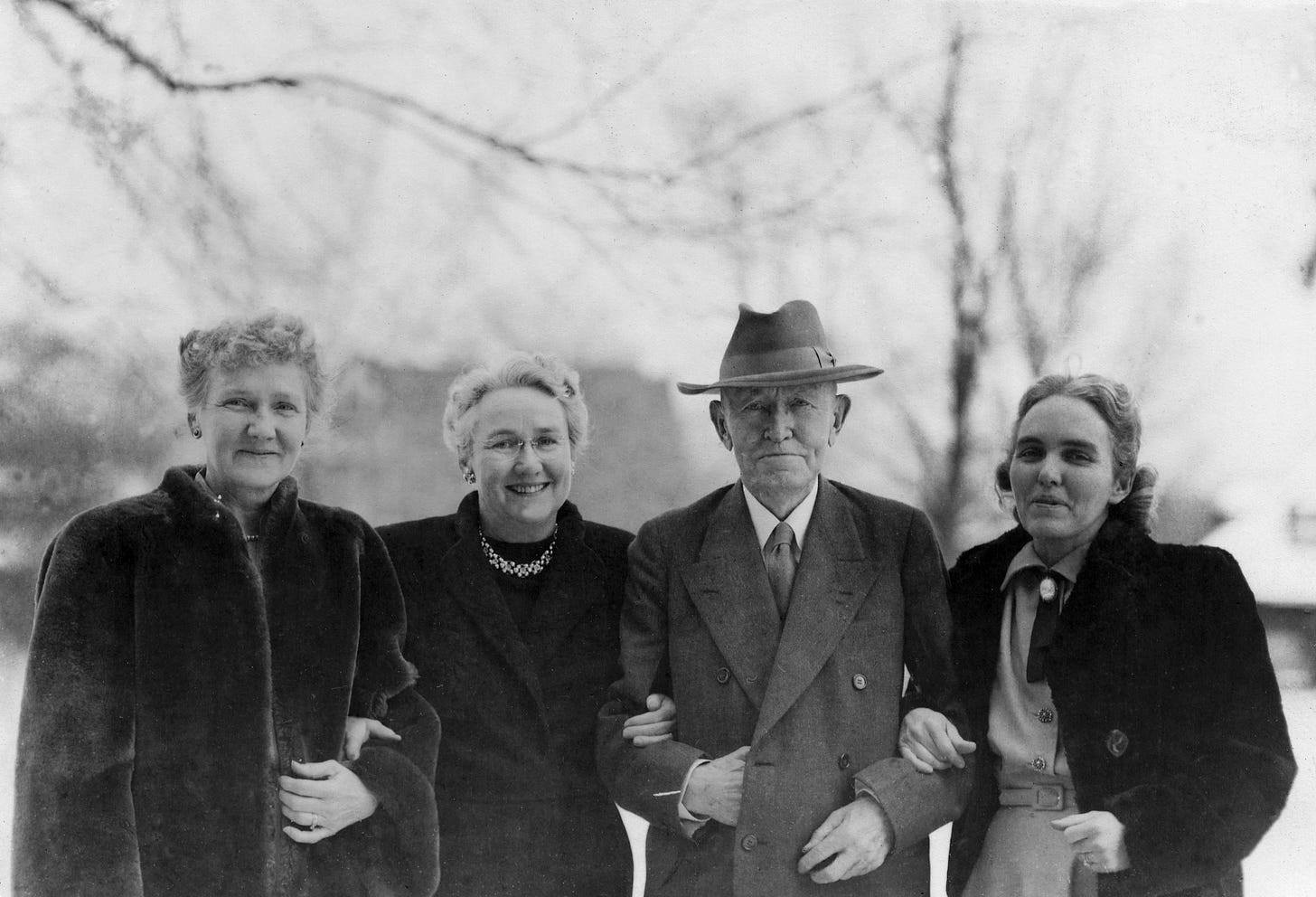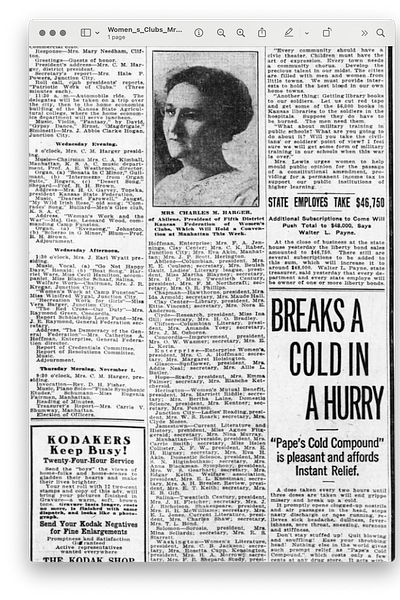Women’s Suffrage & Daughters
The fight for equal rights and universal suffrage took a winding road around the globe. Were the women in your family involved in the campaigns? A women's history cross-over post.
While herding the “Ride Along” at RootsTech, I missed the opportunity to join ’s 31-Day Ancestral Women Challenge. Now I see an opportunity to honor a few of the women in my tree by introducing them in a cross-over post.
Coastin’ with the Suffragettes
Suddenly, I realized I could catch up on the challenge by coasting on the theme of Suffragettes, which Emma Cox will use in her next talk for our Emma Explores series. In our episode on March 20th, Emma will share the story of Florence de Fontblanque, a prominent suffragette in her family tree. At 43, Florence organized a Women’s March over 375 miles from Edinburgh to London to deliver a petition to the Prime Minister for women’s rights.

Suffrage is a theme that references massive social changes in the late 19th and early 20th centuries across the Anglophone world. It also creates a convenient context for exploring ancestors' stories. These stories are recent enough that we likely still have access to their photos and stories. Sometimes, one can use their known birth and death dates and other factors to deduce their activism and maybe politics. Generally, that guesswork should be explored further before compounding assumptions.
Kicking Trees & Taking Names
I started by listing the women in my family tree, radiating from mother and grandmother to great-grandmothers and grand aunts. That’s when I realized how much ages and places would matter. With a focus on my American ancestors, I got serious by sorting my list to find direct ancestors who were born before the US Presidential Election of 19201 but were alive at least a few years after. That gave me a list of ten women, including a very special great aunt.

I started filtering to find a few stories I could focus on in the available time. Soon, I saw the pattern in one family with three sisters. I realized this would have to be just the start of a more extensive series to give each sister her due.
The Harger Family: Three Sisters and Their Remarkable Mother
Henry and Martha Harger, my 2x great-grandparents, moved to rural Kansas in 1879, “responding to the call of the West” to farm the golden wheat fields of the Midwest. By their second year, the farm was lost to a storm, and the family moved to town to start a real estate office.
In the 1880s, Abilene, Kansas, was a small village at the easternmost end of the Chisholm trail. Like a scene from the Old West, this caked trail brought cattle from ranches in the young state of Texas to the growing urban markets from the Kansas Pacific railhead in Abilene, Kansas. It was a town ripe for growth and prosperity for young and enterprising talent.

BLANCHE BRADSHAW (Harger) 1870-1943 was my great-grandmother. She was briefly a pupil taught by my great-grandfather, CHARLES “Charlie” MOREAU HARGER (1863–1955), before they married in 1889. Like the Hargers, the Bradshaw family had moved to the West in a covered wagon on the promise of better land for farming. They “paused” first on a homestead in Pawnee County, Nebraska, where Blanche was born in November 1870. They then settled on a farm near Clyde, Kansas, but their farm was devastated by grasshoppers and drought. They later moved to Hope, in Dickinson County, Kansas, where the family came to run one of the leading farming supply stores.2
Despite his family’s hardship on the farm, Blanche’s future husband Charlie had been sent back to Phelps Academy in New York to finish high school. A close family friend was the head of the school. On his return, Charlie helped his parents with various paying jobs, including herding cattle, assisting a surveyor, and selling books. Soon, he was a teacher and later principal in Hope, Kansas, where he met his future wife, Blanche. By 1888, Charlie landed his dream job as a reporter for the Abilene Reflector-Chronicle. In time, he became the editor and publisher, a position he held for over 65 years, nearly until his passing in 1955.

Charlie and Blanche married in 1889. By then, she had graduated and become a teacher in Hope. They soon moved to a home in Abilene, and as the years went by, they worked to support the intellectual landscape of their growing community. They raised their daughters in an active household as the Reflector-Chronicle newspaper played an outsized role in the growth of modern journalism.
To quote from my grandmother Lois Harger’s family history book3 describing her early life.4:
Ours was the one home to which came the notable visitors to the town. Writers, editors from the city, college presidents, congressmen, governors dropped in. William Allen White was a frequent visitor, Bishop W. A. Quayle, of the Methodist Church, Sheffield Ingalls, Frazier Hunt—all sorts of persons. Its doors were open to every influence that could add to the cultural development of the growing western city. Father and mother made welcome all who could advance the town’s and the state’s intellectual life. We children, listening, open-eyed, to the conversations about literature, education and politics, gained a wide knowledge of the world thereby.
In her book, published in 1948, five years after her mother's death, my grandmother describes her mother as active in social clubs at the height of the women’s club movement. She was president of the Literary League and the Kansas Fifth District Federation of women’s clubs. Though a search of her name finds few articles, searching for “Mrs. C.M. Harger” finds her in the women’s pages of dozens of regional newspapers.
In the late 19th century, women’s suffrage was an issue in Kansas, but local voting rights were already established. The legislature granted women the right to vote in school elections in 1861 and municipal elections in 1887. A women’s suffrage amendment wasn’t added to the state constitution until 1912.
Despite newspaper accounts of efforts to ban smoking and other “good works,” I have no specific evidence that Blanche or any of her daughters were directly involved in the movement that led to women’s suffrage at the national level and the 1920 Presidential Election.
Blanche’s three daughters
LOIS BLANCHE HARGER (Parker) 1891-1964 was my grandmother and the eldest of three sisters. Her interest in Japonisme was a surprise as few of these girlish artifacts from her bedroom remain in the family. Her aesthetic movement writing desk is now a treasured heirloom in my home.
We know Dwight David Eisenhower was her classmate in high school, but I have little specific evidence of her direct role in politics. After marrying in 1915, she moved with her new husband to Schenedity, New York, where he took a role at General Electric and went on to raise her family in the Chicago suburbs.

RUTH MOREAU HARGER (Maxwell) 1982-1975 was my grand aunt, the middle child. Just a year younger than her sister, the two were often grouped together for summers in Colorado, Western Kansas, and Michigan. Like her sister, Ruth graduated from the University of Kansas where they were in the same Theta Sorority.

DOROTHY JEAN HARGER (Harris) 1908-1992 was my grandmother’s much younger sister—and my great aunt. Given the 17-year age gap, when my grandparents married in 1915, “Dottie Jean” was just seven. Her new brother-in-law was a photo-nerd, and she was the perfect subject. Though she was 18 in 1920, federal laws prevented anyone from voting until age 21. Her story is a long one that took her to Colorado, Africa, South America, and eventually, California. In time, she would be my guide into our family story.

I’ve described some of these women in the “My Sixteen” post I shared several months ago and will continue to expand on their stories periodically.
My Sixteen: Ries, Moeller, Harger & Parker
I’ve been smitten by the stories of “My Sixteens,” including Tad’s Mightier Acorns post that started it all. I’m in debt t…
Emma Explores: The Suffragette, Florence de Fontblanque
If you haven’t joined us for one of Emma’s delightful talks for Projectkin, you won’t want to miss this one. You may know Emma for her wonderful Journeys Into Genealogy podcast or as a professional genealogist specializing in England and Scotland. For Projectkin, she dips into her family history to explore their stories based on themes. See recordings of the entire series at Projectkin.org/emma-explores.
The 19th Amendment to the U.S. Constitution, which gave women the right to vote, was passed on June 4, 1919, and ratified on August 18, 1920. The first presidential election women could vote in was 1920.
This story, passed down by my grandmother, Lois Harger, in her self-published book, suggests many questions. I have yet to research the land records.
“Harger & Allied Families,” page 21, self-published in 1948 to a circulation of 100 copies. Now available in abridged form in the Internet Archive.
The unstated theme in this description is the decisive role of the emerging Republican party through these gatherings. Dwight David Eisenhower was a classmate of Lois Harger’s. He was also an employee of her father’s at the Reflector-Chronicle, and Charlie Harger wrote a letter to help him get into West Point. That political connection may be a topic of a future post.











Amazing collection of pioneering women!
Love this take on your family members. I haven’t found any direct suffragettes ties in my family, but with lots of strong women in my lineage, I’m sure they were supportive. Wonderfully written.